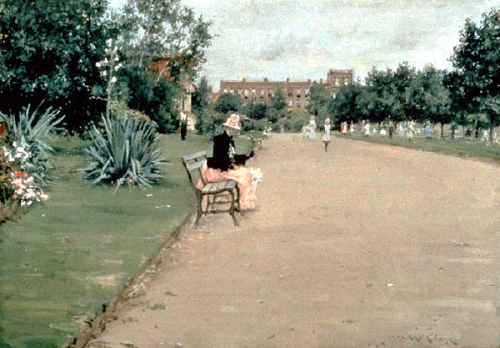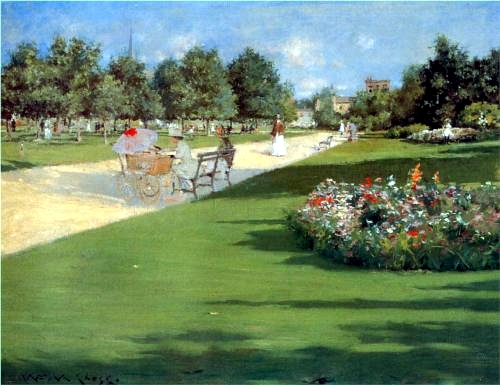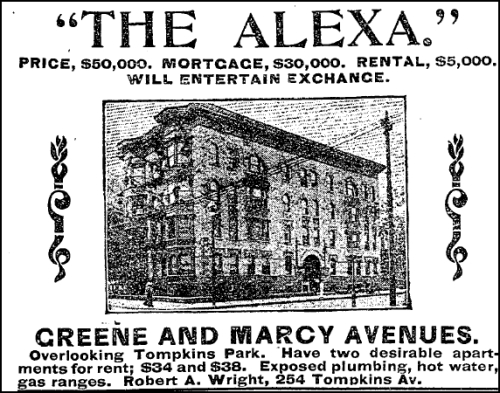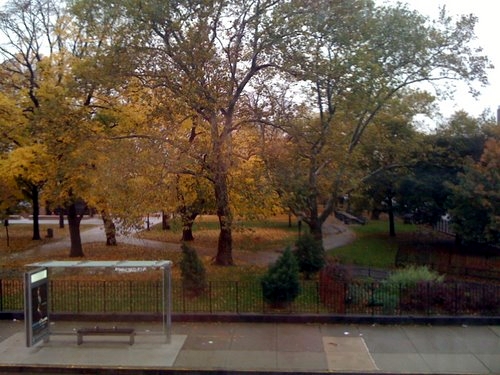Walkabout: Brooklyn's Small Parks: Tompkins Park, Part 2
Frederick Law Olmsted and Calvert Vaux laid out Tompkins Park in 1871.

“In Park,” painted in Tompkins Park in 1887 by William Merritt Chase
Read Part 1 of this story.
Frederick Law Olmsted and Calvert Vaux laid out Tompkins Park in 1871. With Prospect Park still in the works and not yet open, and Washington Park just behind them, they turned to this small parcel of parkland to create an urban oasis in the growing, and fast developing Bedford neighborhood. For more back history, see Part One of the park’s story. Even back then, Bedford was too big to exist under only one name, and it didn’t take long for the Tompkins Park name to be used as a reference and a selling point for new homes.
It was a pretty little park, only 8 acres across two city blocks. Unlike parks with a bit more topography, Tompkins Park is flat, and was carefully and formally set out by Olmsted and Vaux as a very landscaped and verdant space, especially popular with mothers, nurses and their children. Some fine homes and a couple of mansions were built on the Lafayette Avenue side, and the park was ringed by rows of brownstones, and later, elegant flats buildings. A large church also overlooked the park, at the corner of Lafayette and Marcy Avenues.
The fledgling Parks Department, under the leadership of James Stranahan, the first City of Brooklyn Parks Commissioner, had a lot on its plate. More and more parkland was needed, but Stranahan was very busy with his baby, Prospect Park. In spite of some inadvertent official and financial slights to the park, it proved to be a very welcome and popular place. By the 1880s and ’90s, Tompkins Park was home to annual Fourth of July celebrations, they had a very active croquet club, a beautiful new ladies’ respite station, and a temporary branch of Brooklyn’s Public Library. Funds were being raised in 1900 for a permanent branch.
During this time, one of America’s most important Impressionist painters discovered the park, and immortalized it on canvas. His name was William Merritt Chase. He was born in Indiana in 1849, discovered a love and affinity for art at an early age, and studied with some of the masters of the day, both in the United States and Europe. When he returned to the U.S. he settled in, got married, fathered eight children, and had quite a career, painting portraits for Society, landscapes and still lifes.
Like many artists, he had his good years, financially, and his rough years, but for the most part, he did quite well. When he and his beloved wife and muse, Alice, were first married, and when they had their first child, they lived with his parents on Marcy Avenue, in Bedford, right near the park. Chase would paint at least five landscapes of Tompkins Park, some featuring his wife and daughter, and others showing people strolling and enjoying the park.
One painting, “In Tompkins Park” (1887) now hangs at the Art Institute of Chicago, and the other, “Tompkins Park” (1887), is at the Colby College of Art Museum, in Maine. Both are classic Chase landscapes, lovely scenes with people, rendered in the Impressionistic style. They are both important works, and are probably the first color representations of Bedford Stuyvesant on record. Chase also painted many scenes of Prospect Park and Central Park, and other locations in Brooklyn, in addition to his other landscapes, as well as many other portraits and other works.
William Merritt Chase was one of America’s most important artists and teachers. He discovered he enjoyed teaching, and taught a new generation of American painters and artists for over almost 30 years. In 1887, and from 1891 to 1896, he taught at the Brooklyn Art Association, an arts society founded in 1861, which was eventually absorbed in to the Brooklyn Institute of Art and Science, later called the Brooklyn Museum.
He taught many pupils at the Arts Student League, the Pennsylvania Academy of the Fine Arts, and his own Shinnecock Summer School of Art, and his New York School of Art. His students at included Edward Hopper and Georgia O’Keefe, among many others. The Chase School of Art he founded in 1897 would become the New York School of Art, which would one day become Parsons School of Design, one of America’s finest arts institutions. William Merritt Chase died in New York in 1916.
Meanwhile, Tompkins Park was undergoing some changes, as the neighborhood around it also changed. Unlike the streets around some other parks, like Prospect Park, the streets facing the park never became exclusive enclaves of the rich. Most of the homes around the park are modest, by comparison; they were the same homes as the ones the middle and upper-middle class people were buying in the side blocks. This part of Bedford never really attracted the really wealthy. However, there were amenties. “In Park,” the painting above, shows an ice cream parlor on the street behind the park. It was probably on Tompkins Avenue.
There are over one thousand entries in the Brooklyn Eagle database for “Tompkins Park,” and 98 percent of them are advertisements for apartments and rooms to rent. Most of the houses that were offered for sale, or had rooms for rent, or were boarding houses, overlooked the park, mostly on Greene and Marcy Avenues. By 1900, at least two large flats buildings stood facing the park; both diagonal to each other, on the corner of Greene and Marcy Avenues. One, the “Alexa” had a large advertisement with a photo, which ran in the Eagle in 1902. Apartments rented for $34 and $38 a month. This building is now gone, although its neighbor is still standing. They were quite elegant, for their day.
In 1915, the Parks Department began to change Olmsted and Vaux’s layout. A large seating space was cleared for the crowds who came to hear regimental band concerts in the park. The branch of the Brooklyn Library was now permanently housed in the lady’s respite shelter, having supplanted the croquet clubs and their equipment. This branch was here until the building burned down in 1969. In 1927, a children’s playground was built, and at some point, trees were planted, and the pathways were redesigned, no longer in the formal shapes of the past. Today, there is nothing left of the original layout.
Like all of our city parks, the mid-20th century was not a good time for Tompkins Park. This park had a harder time than most, being in what was called “America’s worst ghetto.” But many people had not given up on either the community, or the park. In 1969, the fire that destroyed the library also caused a grassroots organization to be formed; the Tompkins Park Recreation and Cultural Association. They were fierce advocates for the park, lobbying the city for more funds for the park, as well as staff to take care of it. Today, unless you were here to remember it, it’s hard to remember how bad all of the parks in New York City were, and how little money was allocated to keep them up. The Association had an uphill fight.
Fortunately, they had the Magnolia Earth Tree Center on Lafayette Avenue, just across the street from the park, the brainchild of Hattie Carthan, a fierce advocate for urban gardening, and a terrific grass roots organizer for Bedford Stuyvesant. In 1973, the group was able to get a new recreation center built in the center of the park. It housed the Eubie Blake Auditorium, a senior center, a teen center, and an amphitheater.
In 1985, Tompkins Park was renamed “Herbert Von King Park,” after a local long-time community activist, who championed Bed Stuy causes and improvements for over fifty years. A local building contractor, he had founded Boy Scout Troop 219 in 1933, had been on the local school board, the Police Civilian Committee, and the board of the Magnolia Earth Tree Center. In 1983, Mr. King also received awards from the State Senate, City Council, and the 81st Precinct in recognition of his long years of community service. The man called the “Mayor of Bedford Stuyvesant” died in 1985.
In 2011, the amphitheater was renamed, and is now called the Almira Kennedy Coursey Amphitheater. Mrs. Coursey, who died in 1996, was a school teacher, and full-time community organizer for her Bedford Stuyvesant community. She had been serving the community since working on anti-poverty programs in the Wagner and Lindsay administrations.
Today, the park is once again getting a resurgence of interest. The Von King Community Center has computer facilities available, as well as an arts room for children and a performance stage. It also has ball fields, handball courts and playgrounds, as well as pathways and benches underneath overhanging shade trees and a dog run. A new community group called the “Friends of Von King Park” has been busy planting new bulbs and plants, and cleaning up and beautifying the park for the last two years, and plans to make sure that the park is once again as beautiful as it was when William Merritt Chase immortalized it for posterity. GMAP





Related Stories
Walkabout: Brooklyn’s Small Parks: St John’s Park
Walkabout: Brooklyn’s Small Parks: Saratoga Park
Walkabout: Brooklyn’s Small Parks: Brower Park, Pt 1
Walkabout: Brooklyn’s Small Parks: Brower Park, Pt 2





What's Your Take? Leave a Comment